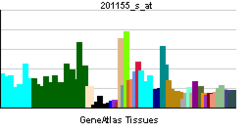MFN2
| View/Edit Human | View/Edit Mouse |
Mitofusin-2 is a protein that in humans is encoded by the MFN2 gene.[3][4] Mitofusins are GTPases embedded in the outer membrane of the mitochondria. In mammals MFN1 and MFN2 are essential for mitochondrial fusion.[5]
Function
Mitofusin-2 is a mitochondrial membrane protein that participates in mitochondrial fusion and contributes to the maintenance and operation of the mitochondrial network.[6] Mitochondria function as a dynamic network constantly undergoing fusion and fission. The balance between fusion and fission is important in maintaining the integrity of the mitochondria and facilitates the mixing of the membranes and the exchange of DNA between mitochondria. MFN1 and MFN2 mediate outer membrane fusion while OPA1 is involved in inner membrane fusion.[7]
Mitochondrial fusion is essential for embryonic development. knockout mice for either MFN1 or MFN2 have fusion deficits and die midgestation. MFN2 knockout mice die at embryonic day 11.5 due to a defect in the giant cell layer of the placenta.[5]
Fusion is also important for mitochondrial transport and localization in neuronal processes.[8] Conditional MFN2 knockout mice show degeneration in the Purkinje cells of the cerebellum, as well as improperly localized mitochondria in the dendrites.[9] MFN2 also associates with the MIRO-Milton complex which links the mitochondria to the kinesin motor.[8]
Clinical significance
Mutations of the gene are implicated in Charcot-Marie-Tooth disease. Charcot-Marie-Tooth disease type 2A (CMT2A) is caused by mutations in the MFN2 gene. While the symptoms of CMT2A are variable they are characterized by a sometimes early onset, severe phenotype, and optic atrophy. Mutations in OPA1 also cause optic atrophy, which suggests a common role of mitochondrial fusion in neuronal dysfunction.[9] The exact mechanism of how mutations in MFN2 selectively cause the degeneration of long peripheral axons is not known. There is evidence suggesting that it could be due to defects in the axonal transport of mitochondria.[9]
The MFN2 protein may play a role in the pathophysiology of obesity.[10]
This protein is involved in the regulation of vascular smooth muscle cell proliferation.[6]
References
- ↑ "Human PubMed Reference:".
- ↑ "Mouse PubMed Reference:".
- ↑ Karbowski M, Lee YJ, Gaume B, Jeong SY, Frank S, Nechushtan A, Santel A, Fuller M, Smith CL, Youle RJ (Dec 2002). "Spatial and temporal association of Bax with mitochondrial fission sites, Drp1, and Mfn2 during apoptosis". J Cell Biol. 159 (6): 931–8. doi:10.1083/jcb.200209124. PMC 2173996
 . PMID 12499352.
. PMID 12499352. - ↑ Santel A, Fuller MT (Feb 2001). "Control of mitochondrial morphology by a human mitofusin". J Cell Sci. 114 (Pt 5): 867–74. PMID 11181170.
- 1 2 Chan DC (June 2006). "Mitochondria: dynamic organelles in disease, aging, and development". Cell. 125 (7): 1241–52. doi:10.1016/j.cell.2006.06.010. PMID 16814712.
- 1 2 "Entrez Gene: MFN2 mitofusin 2".
- ↑ Chan DC (November 2006). "Dissecting mitochondrial fusion". Dev. Cell. 11 (5): 592–4. doi:10.1016/j.devcel.2006.10.009. PMID 17084350.
- 1 2 Sheng ZH, Cai Q (February 2012). "Mitochondrial transport in neurons: impact on synaptic homeostasis and neurodegeneration". Nat. Rev. Neurosci. 13 (2): 77–93. doi:10.1038/nrn3156. PMID 22218207.
- 1 2 3 Cartoni R, Martinou JC (August 2009). "Role of mitofusin 2 mutations in the physiopathology of Charcot-Marie-Tooth disease type 2A". Exp. Neurol. 218 (2): 268–73. doi:10.1016/j.expneurol.2009.05.003. PMID 19427854.
- ↑ Zorzano A, Sebastián D, Segalés J, Palacín M (September 2009). "The molecular machinery of mitochondrial fusion and fission: An opportunity for drug discovery?". Curr Opin Drug Discov Devel. 12 (5): 597–606. PMID 19736619.
Further reading
- Zorzano A, Bach D, Pich S, Palacín M (2004). "[Role of novel mitochondrial proteins in energy balance]". Revista de medicina de la Universidad de Navarra. 48 (2): 30–5. PMID 15382611.
- Pawlikowska P, Orzechowski A (2007). "[Role of transmembrane GTPases in mitochondrial morphology and activity]". Postepy Biochem. 53 (1): 53–9. PMID 17718388.

